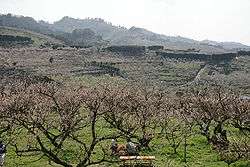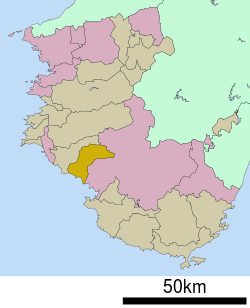Minabe, Wakayama
Minabe (みなべ町, Minabe-chō) is a small town located in Hidaka District, Wakayama Prefecture in the Kansai region of Japan. Situated on a small bay of the Pacific ocean and surrounded by mountains, it is a quiet and picturesque farming community of about 12,500 people. Its location has been mentioned in ancient texts since the 8th century, but the basic land area was incorporated in 1889. After a series of village mergers, the present area of Minabe was formed in 2004. Minabe is known for its high-quality apricots, known as Ume. It is also known for a high-quality charcoal called Binchōtan, has good fishing waters, and produces a variety of agricultural goods.
Minabe みなべ町 | |
|---|---|
Town | |
 Minabe Plum-grove, as known for a plum grove site in Japan | |
 Flag  Emblem | |
 Location of Minabe in Wakayama Prefecture | |
 Minabe | |
| Coordinates: 33°46′21″N 135°19′14″E | |
| Country | Japan |
| Region | Kansai |
| Prefecture | Wakayama Prefecture |
| Government | |
| • Mayor | Yoshimasa Kotani |
| Area | |
| • Total | 120.26 km2 (46.43 sq mi) |
| Population (October 1, 2016) | |
| • Total | 12,561 |
| • Density | 100/km2 (270/sq mi) |
| Time zone | UTC+9 (Japan Standard Time) |
| Symbols | |
| • Tree | Ubame oak (Quercus phillyraeoides) |
| • Flower | Ume (Prunus mume) |
| • Bird | Japanese bush warbler (Cettia diphone) |
| • Fish | Japanese sardine (Sardinops melanostictus) |
| Phone number | 0739-72-2015 |
| Address | 742 Shiba, Minabe-chō, Hidaka-gun, Wakayama-ken 645-0002 |
| Website | Minabe Town |
Geography
Minabe is located at the southernmost edge of Hidaka District in central Wakayama Prefecture. The main part of Minabe, including the train station, government buildings, and business district, lies around the basin of the Minabe River as it flows into Minabe Bay on the Pacific Ocean. There are three distinguishing features of Minabe Bay: Kashima Island situated approximately 1 km offshore, a long non-swimming beach that runs parallel to the central business district, and two prominent rocky points at either end. The central area of town is largely flat and comprises the majority of houses and people. It is moderately populated, with many cultivated fields and buildings.
To the west-northwest of central Minabe is the Iwashiro region which is centered on the Iwashiro River Basin. This area is lightly populated and a mixture of farmland and forested mountains. It also features sections of non-swimming beaches.
Following the Minabe River northeast one comes to the Kamiminabe region. This area is partly mountainous and comprises the majority of the town’s ume trees. Following the river farther upwards, the valley becomes increasingly narrow and forested, with little ground suitable for cultivation or houses. The path of the Minabe River here is narrow, no more than 30m across. There is little to nothing in the way of buildings or cultivated fields. Approximately 8 kilometers from the center of town is the lightly populated region of Takagi which features some farmland and houses. A further 6 kilometers up the river valley is the even smaller region of Kiyokawa, which is the end of Minabe. The highest point is located here: 768m.
On October 1, 2004 the village of Minabegawa, from Hidaka District, was merged into Minabe.
Economy
Minabe is a large producer of two important agricultural products in Japan. One is Umeboshi (Japanese pickled plum). Minabe produces grows and processes more plums than any other place in Japan. The plums are primarily grown on the hillsides and mountainsides of the small valley around the Minabe River. Ume are used almost inclusively in food products ranging from the aforementioned Umeboshi to cooking sauces to ice cream.
The other product is a traditional charcoal called Binchōtan. Minabe currently produces the second most Binchōtan of any place in Japan. This charcoal is produced in small, family-operated outdoor kilns primarily in the upper mountainous areas of Minabe. It is used in a wide variety of products: soaps and shampoos, ornaments, musical instruments, air fresheners, and many others.
While much of Minabe's economy is agricultural, it does have several businesses and other industries. The town supports a small business district centered on its train station, as well as 3 full-service hotels and several restaurants and cafes.
References
External links
- Official Minabe homepage (in Japanese)
- Minabe Tourist Information Center (in Japanese)
| Wikimedia Commons has media related to Minabe, Wakayama. |